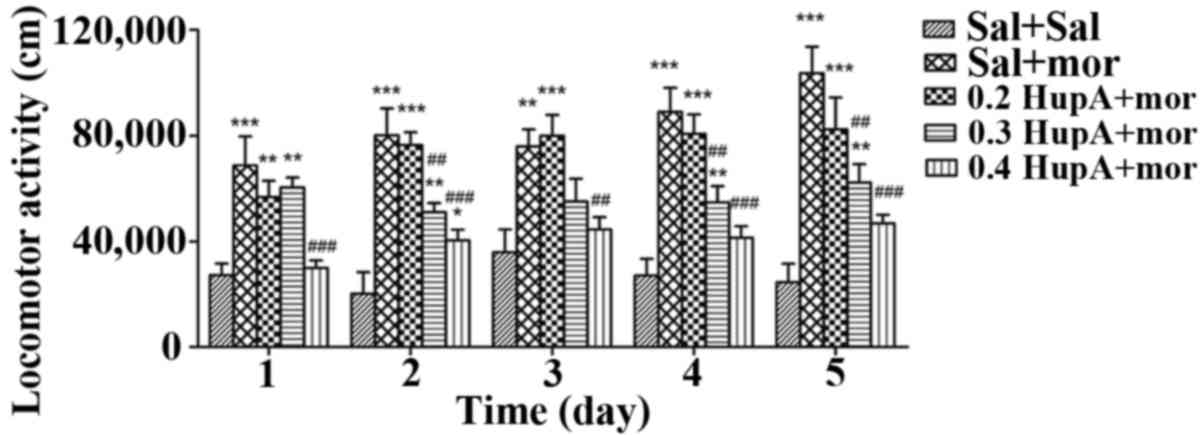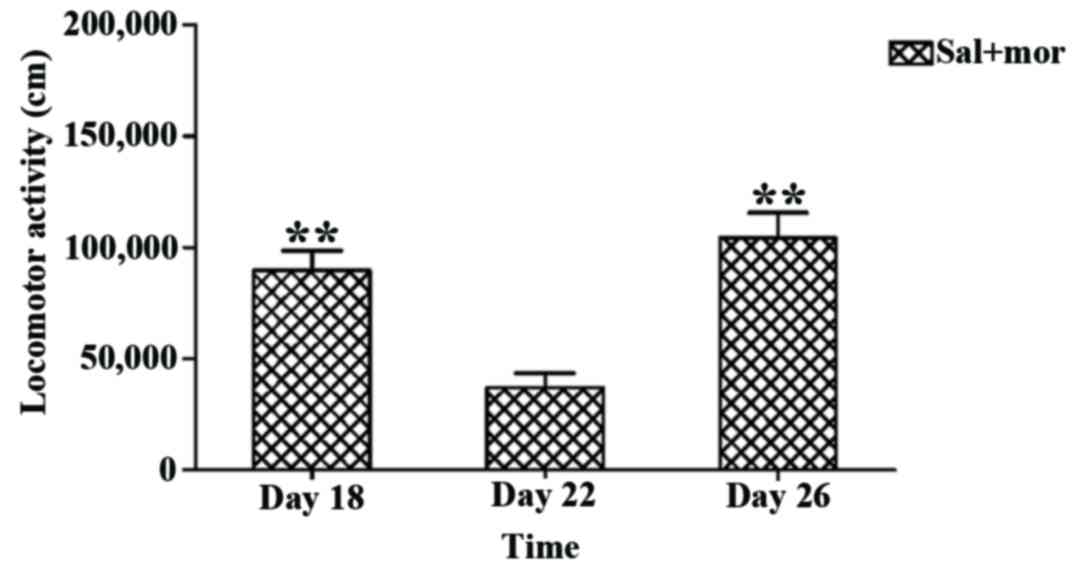|
1
|
Wang R, Yan H and Tang XC: Progress in
studies of huperzine A, a natural cholinesterase inhibitor from
Chinese herbal medicine. Acta Pharmacol Sin. 27:1–26. 2006.
View Article : Google Scholar : PubMed/NCBI
|
|
2
|
Ma T, Gong K, Yan Y, Zhang L, Tang P,
Zhang X and Gong Y: Huperzine A promotes hippocampal neurogenesis
in vitro and in vivo. Brain Res. 1506:35–43. 2013. View Article : Google Scholar : PubMed/NCBI
|
|
3
|
Yang Y, Yang J and Jiang Q: The protective
effect of huperzine A against hepatic ischemia reperfusion injury
in mice. Transplant Proc. 46:1573–1577. 2014. View Article : Google Scholar : PubMed/NCBI
|
|
4
|
Ou LY, Tang XC and Cai JX: Effect of
huperzine A on working memory in reserpine- or yohimbine-treated
monkeys. Eur J Pharmacol. 433:151–156. 2001. View Article : Google Scholar : PubMed/NCBI
|
|
5
|
Zhang HY, Yan H and Tang XC:
Non-cholinergic effects of huperzine A: Beyond inhibition of
acetylcholinesterase. Cell Mol Neurobiol. 28:173–183. 2008.
View Article : Google Scholar : PubMed/NCBI
|
|
6
|
Tang XC: Huperzine A (shuangyiping): A
promising drug for Alzheimer's disease. Zhongguo Yao Li Xue Bao.
17:481–484. 1996.PubMed/NCBI
|
|
7
|
Liang YQ and Tang XC: Comparative effects
of huperzine A, donepezil and rivastigmine on cortical
acetylcholine level and acetylcholinesterase activity in rats.
Neurosci Lett. 361:56–59. 2004. View Article : Google Scholar : PubMed/NCBI
|
|
8
|
Zhang HY and Tang XC: Neuroprotective
effects of huperzine A: New therapeutic targets for
neurodegenerative disease. Trends Pharmacol Sci. 27:619–625. 2006.
View Article : Google Scholar : PubMed/NCBI
|
|
9
|
Ma X and Gang DR: In vitro production of
huperzine A, a promising drug candidate for Alzheimer's disease.
Phytochemistry. 69:2022–2028. 2008. View Article : Google Scholar : PubMed/NCBI
|
|
10
|
Hikida T, Kitabatake Y, Pastan I and
Nakanishi S: Acetylcholine enhancement in the nucleus accumbens
prevents addictive behaviors of cocaine and morphine. Proc Natl
Acad Sci USA. 100:6169–6173. 2003. View Article : Google Scholar : PubMed/NCBI
|
|
11
|
Handal M, Ripel A, Skurtveit S and Mørland
J: Behavioural sensitization in mice induced by
morphine-glucuronide metabolites. Pharmacol Biochem Behav.
90:578–585. 2008. View Article : Google Scholar : PubMed/NCBI
|
|
12
|
Robinson TE and Berridge KC: The neural
basis of drug craving: An incentive-sensitization theory of
addiction. Brain Res Brain Res Rev. 18:247–291. 1993. View Article : Google Scholar : PubMed/NCBI
|
|
13
|
Pierce RC and Kalivas PW: Repeated cocaine
modifies the mechanism by which amphetamine releases dopamine. J
Neurosci. 17:3254–3261. 1997.PubMed/NCBI
|
|
14
|
Sanchis-Segura C and Spanagel R:
Behavioural assessment of drug reinforcement and addictive features
in rodents: An overview. Addict Biol. 11:2–38. 2006. View Article : Google Scholar : PubMed/NCBI
|
|
15
|
Tortorelli LS, Engelke DS, Lunardi P, E
Souza T Mello, Santos-Junior JG and Gonçalves CA: Cocaine
counteracts LPS-induced hypolocomotion and triggers locomotor
sensitization expression. Behav Brain Res. 287:226–229. 2015.
View Article : Google Scholar : PubMed/NCBI
|
|
16
|
Didone V, Quoilin C, Tirelli E and
Quertemont E: Parametric analysis of the development and expression
of ethanol-induced behavioral sensitization in female Swiss mice:
Effects of dose, injection schedule and test context.
Psychopharmacology (Berl). 201:249–260. 2008. View Article : Google Scholar : PubMed/NCBI
|
|
17
|
Li X, Li JX, Zhu X, Cui R and Jiao J:
Effects of physostigmine on the conditioned hyperactivity and
locomotor sensitization to morphine in rats. Behav Brain Res.
206:223–228. 2010. View Article : Google Scholar : PubMed/NCBI
|
|
18
|
Ball KT, Klein JE, Plocinski JA and Slack
R: Behavioral sensitization to 3,4-methylenedioxymethamphetamine is
long-lasting and modulated by the context of drug administration.
Behav Pharmacol. 22:847–850. 2011. View Article : Google Scholar : PubMed/NCBI
|
|
19
|
Collins GT, Truong YN, Levant B, Chen J,
Wang S and Woods JH: Behavioral sensitization to cocaine in rats:
Evidence for temporal differences in dopamine D3 and D2 receptor
sensitivity. Psychopharmacology (Berl). 215:609–620. 2011.
View Article : Google Scholar : PubMed/NCBI
|
|
20
|
Zhang Q, Li JX, Zheng JW, Liu RK and Liang
JH: L-type Ca(2+) channel blockers inhibit the development but not
the expression of sensitization to morphine in mice. Eur J
Pharmacol. 467:145–150. 2003. View Article : Google Scholar : PubMed/NCBI
|
|
21
|
Brody AL, Mandelkern MA, London ED,
Childress AR, Lee GS, Bota RG, Ho ML, Saxena S, Baxter LR Jr,
Madsen D and Jarvik ME: Brain metabolic changes during cigarette
craving. Arch Gen Psychiatry. 59:1162–1172. 2002. View Article : Google Scholar : PubMed/NCBI
|
|
22
|
Weiss F: Neurobiology of craving,
conditioned reward and relapse. Curr Opin Pharmacol. 5:9–19. 2005.
View Article : Google Scholar : PubMed/NCBI
|
|
23
|
Zironi I, Burattini C, Aicardi G and Janak
PH: Context is a trigger for relapse to alcohol. Behav Brain Res.
167:150–155. 2006. View Article : Google Scholar : PubMed/NCBI
|
|
24
|
Schulteis G, Liu J, Amitai N and Tzeng S:
Context- and cue-conditioned potentiation of acute morphine
dependence and withdrawal. Pharmacol Biochem Behav. 82:82–89. 2005.
View Article : Google Scholar : PubMed/NCBI
|
|
25
|
Carlezon WA Jr, Mendrek A and Wise RA:
MK-801 disrupts the expression but not the development of
bromocriptine sensitization: A state-dependency interpretation.
Synapse. 20:1–9. 1995. View Article : Google Scholar : PubMed/NCBI
|
|
26
|
Wise RA, Mendrek A and Carlezon WA Jr:
MK-801 (dizocilpine): Synergist and conditioned stimulus in
bromocriptine-induced psychomotor sensitization. Synapse.
22:362–368. 1996. View Article : Google Scholar : PubMed/NCBI
|
|
27
|
Stephens DN, Elliman TD and Dunworth SJ:
State-dependent behavioural sensitization: Evidence from a
chlordiazepoxide state. Behav Pharmacol. 11:161–167. 2000.
View Article : Google Scholar : PubMed/NCBI
|
|
28
|
Gancarz AM, San George MA, Ashrafioun L
and Richards JB: Locomotor activity in a novel environment predicts
both responding for a visual stimulus and self-administration of a
low dose of methamphetamine in rats. Behav Processes. 86:295–304.
2011. View Article : Google Scholar : PubMed/NCBI
|
|
29
|
Institute of Laboratory Animal Resources;
Commission on Life Sciences; National Research Council, . Guide for
the Care and Use of Laboratory Animals. National Academy Press;
Washington, D.C: 1996
|
|
30
|
Ye JW, Shang YZ, Wang ZM and Tang XC:
Huperzine A ameliorates the impaired memory of aged rat in the
Morris water maze performance. Acta Pharmacol Sin. 21:65–69.
2000.PubMed/NCBI
|
|
31
|
Wang ZF, Tang LL, Yan H, Wang YJ and Tang
XC: Effects of huperzine A on memory deficits and neurotrophic
factors production after transient cerebral ischemia and
reperfusion in mice. Pharmacol Biochem Behav. 83:603–611. 2006.
View Article : Google Scholar : PubMed/NCBI
|
|
32
|
Myhrer T, Enger S and Aas P: Behavioral
side effects in rats treated with acetylcholinesterase inhibitors
suggested used as prophylactics against nerve agents. Pharmacol
Biochem Behav. 95:338–343. 2010. View Article : Google Scholar : PubMed/NCBI
|
|
33
|
Gawel K, Labuz K, Jenda M, Silberring J
and Kotlinska JH: Influence of cholinesterase inhibitors, donepezil
and rivastigmine on the acquisition, expression and reinstatement
of morphine-induced conditioned place preference in rats. Behav
Brain Res. 268:169–176. 2014. View Article : Google Scholar : PubMed/NCBI
|
|
34
|
Lee JL, Milton AL and Everitt BJ:
Cue-induced cocaine seeking and relapse are reduced by disruption
of drug memory reconsolidation. J Neurosci. 26:5881–5887. 2006.
View Article : Google Scholar : PubMed/NCBI
|
|
35
|
Bevins RA and Bardo MT:
Morphine-conditioned changes in locomotor activity: Role of the
conditioned stimulus. Exp Clin Psychopharm. 6:131–138. 1998.
View Article : Google Scholar
|
|
36
|
Xinwang L, Aihong X, Bin Z, Ping Y and
Chunyan G: Physostigmine blocks behavioral locomotor sensitization
induced by morphine in rats. Acta Psychologica Sinica. 37:362–365.
2005.
|
|
37
|
Xinwang L, Aihong X, Bin Y, Jia W and
Chunyan G: Effects of scopolamine on behavioral sensitization
induced by morphine in rats. Acta Psychologica Sinica. 39:299–305.
2007.
|
|
38
|
Bevins RA, Besheer J and Pickett KS:
Nicotine-conditioned locomotor activity in rats: Dopaminergic and
GABAergic influences on conditioned expression. Pharmacol Biochem
Behav. 68:135–145. 2001. View Article : Google Scholar : PubMed/NCBI
|
|
39
|
Reid MS, Ho LB and Berger SP: Behavioral
and neurochemical components of nicotine sensitization following
15-day pretreatment: Studies on contextual conditioning. Behav
Pharmacol. 9:137–148. 1998.PubMed/NCBI
|
|
40
|
Wei S and Li X: Differential effects of
propranolol on conditioned hyperactivity and locomotor
sensitization induced by morphine in rats. Sci Rep.
4:37862014.PubMed/NCBI
|
|
41
|
Kawaguchi Y, Wilson CJ, Augood SJ and
Emson PC: Striatal interneurones: Chemical, physiological and
morphological characterization. Trends Neurosci. 18:527–535. 1995.
View Article : Google Scholar : PubMed/NCBI
|
|
42
|
Zhao Q and Tang XC: Effects of huperzine A
on acetylcholinesterase isoforms in vitro: Comparison with tacrine,
donepezil, rivastigmine and physostigmine. Eur J Pharmacol.
455:101–107. 2002. View Article : Google Scholar : PubMed/NCBI
|
|
43
|
Nakanishi S, Kaneko S, Hikida T, Watanabe
D and Pastan I: Role of synaptic integration of dopaminergic and
cholinergic transmission in basal ganglia function. International
Congress Series. 1250:487–492. 2003. View Article : Google Scholar
|
|
44
|
Powell KR and Holtzman SG: Parametric
evaluation of the development of sensitization to the effects of
morphine on locomotor activity. Drug Alcohol Depend. 62:83–90.
2001. View Article : Google Scholar : PubMed/NCBI
|
|
45
|
Kalivas PW and Stewart J: Dopamine
transmission in the initiation and expression of drug- and
stress-induced sensitization of motor activity. Brain Res Brain Res
Rev. 16:223–244. 1991. View Article : Google Scholar : PubMed/NCBI
|
|
46
|
Vezina P and Stewart J: The effect of
dopamine receptor blockade on the development of sensitization to
the locomotor activating effects of amphetamine and morphine. Brain
Res. 499:108–120. 1989. View Article : Google Scholar : PubMed/NCBI
|
|
47
|
Jeziorski M and White FJ: Dopamine
receptor antagonists prevent expression, but not development, of
morphine sensitization. Eur J Pharmacol. 275:235–244. 1995.
View Article : Google Scholar : PubMed/NCBI
|
|
48
|
Brady AM, Glick SD and O'Donnell P:
Changes in electrophysiological properties of nucleus accumbens
neurons depend on the extent of behavioral sensitization to chronic
methamphetamine. Ann N Y Acad Sci. 1003:358–363. 2003. View Article : Google Scholar : PubMed/NCBI
|
|
49
|
Rezayof A, Nazari-Serenjeh F, Zarrindast
MR, Sepehri H and Delphi L: Morphine-induced place preference:
Involvement of cholinergic receptors of the ventral tegmental area.
Eur J Pharmacol. 562:92–102. 2007. View Article : Google Scholar : PubMed/NCBI
|
|
50
|
Robinson TE and Berridge KC: Addiction.
Annu Rev Psychol. 54:25–53. 2003. View Article : Google Scholar : PubMed/NCBI
|
|
51
|
Tang XC and Han YF: Pharmacological
profile of uperzine A, a novel acetylcholinesterase inhibitor from
Chinese herb. CNS Drug Reviews. 5:281–300. 1999. View Article : Google Scholar
|
|
52
|
Tang XC, Han YF, Chen XP and Zhu XD:
Effects of huperzine A on learning and the retrieval process of
discrimination performance in rats. Zhongguo Yao Li Xue Bao.
7:507–511. 1986.(In Chinese). PubMed/NCBI
|
|
53
|
Xiong ZQ and Tang XC: Effect of huperzine
A, a novel acetylcholinesterase inhibitor, on radial maze
performance in rats. Pharmacol Biochem Behav. 51:415–419. 1995.
View Article : Google Scholar : PubMed/NCBI
|
|
54
|
Blake MG, Krawczyk MC, Baratti CM and
Boccia MM: Neuropharmacology of memory consolidation and
reconsolidation: Insights on central cholinergic mechanisms. J
Physiol Paris. 108:286–291. 2014. View Article : Google Scholar : PubMed/NCBI
|















